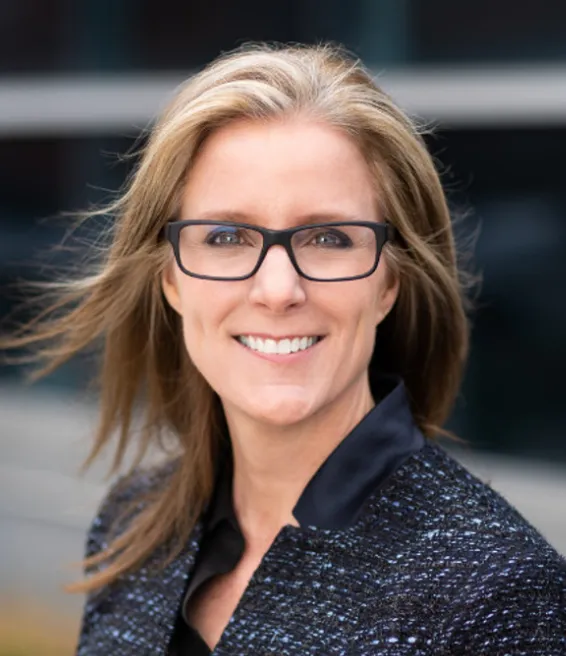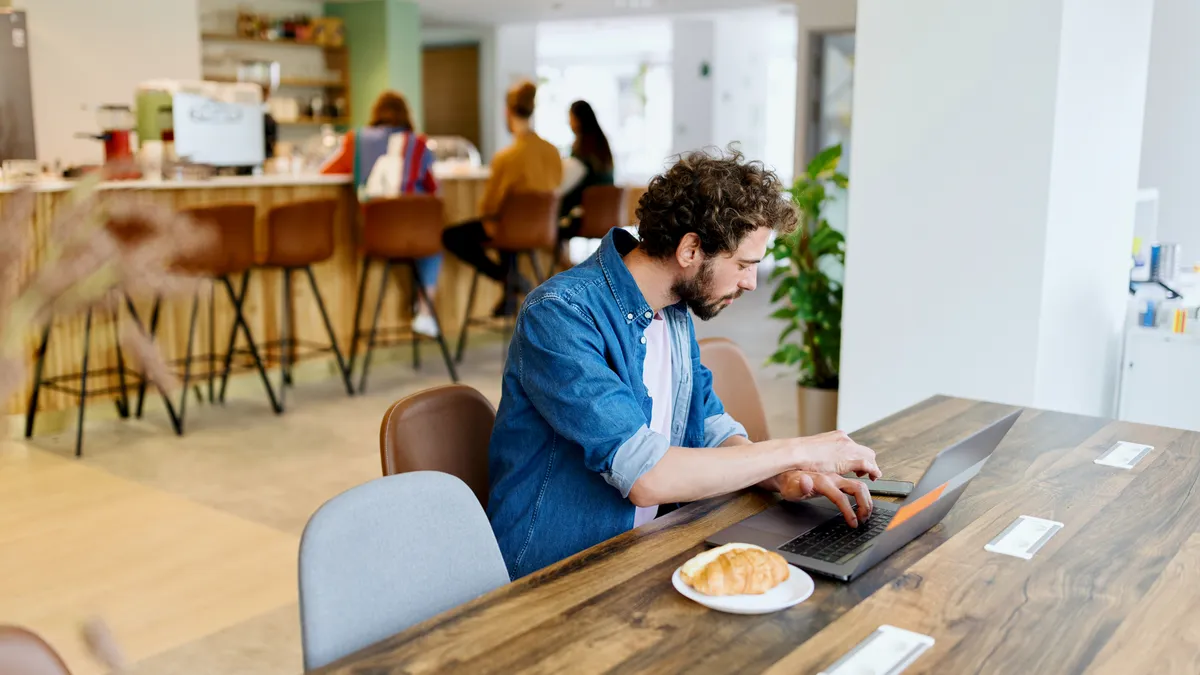With building owners and workplace operators assessing the impact of return-to-office and hybrid work models on their organizations and portfolios, there is a growing emphasis on optimizing workspaces and operations to best serve the needs of organizations and employees. While the concept of workplace experience is not new, it is becoming increasingly important as operators seek to improve utilization and create better places to work.

Amy O’Neil is an executive at the forefront of that charge. Appointed late last year and announced in January as Sodexo’s president of workplace experience for corporate services in the U.S., O’Neil is responsible for elevating the company’s integrated workplace experience solutions and helping the company to grow its leadership in the field.
Editor’s note: This interview has been edited for grammar, length and clarity.
FACILITIES DIVE: Can you explain your new role at Sodexo and what “workplace experience” means to you?
My role as president of workplace in the U.S. includes our integrated facilities management business and it includes standing up and formalizing our go-to-market approach for workplace experience. Part of that is food. It's my belief that food was ... the first workplace experience program, if you will. [If] you go back to how Sodexo was founded ... [it] grew up principally as a food company. It is known as a food company in many places, but [it is] also a facilities management enterprise.
And when we think about food and the workplace, since [Sodexo was founded], there's been a massive evolution of both of those things. To me, Sodexo was really well positioned because of its DNA to be in the workplace experience business. That's what I would consider broad tent, if you will, in terms of what workplace experience means, what my remit is and what I think workplace experience is today.
It's important to point out that employee experience and workplace experience are nearly one and the same. They are words that mean a lot [of things] to a lot of people, and not necessarily the same thing. Oftentimes, it depends on where you sit in an organization.
Employee experience started off years ago, in the purview of the chief people officer or the chief human resources officer, but workplace experience has been or become somewhat in the remit of the real estate function in a lot of organizations. And now, those things are really starting to blur to be a strategy around people. To me, it's the offices, the physical space where work takes place. You can think of that in terms of a brand for a retail business. It is [also] the digital space, the in-digital life aspect of where employees work as a part of being within an organization. It's the people within the organization that process the systems, and how that really comes together.
What are organizations looking for to improve their workplace experience, help employees and reorganize their operations?
That answer depends on the client [and] the employer. And [it] can depend on how a client thinks about this today. They may be on a journey, where they don't think about it per se as strategically as maybe a different client. But the opposite is also true. We have many clients that are extremely strategic about this because they think about their people as the most important part of their business. I think COVID probably accelerated some things that would have happened anyway. We already had this evolution taking place that started many years ago — in some cases, led by technology firms. The U.S. economy has moved from more production and labor-oriented to more of a service-oriented and knowledge-worker based economy. I think that that's really what underpins much of the evolution taking place.
Some of what I hear clients talking about ... is how they need to be thinking about designing, whether it's space, technology tools or ways of working [to find] that increased level of engagement and increased effectiveness. COVID was just a watershed moment. I think it disconnected us from the idea that “what I do every day needs to happen in a certain place.” That process is going to continue, because there's clearly an awareness and a commitment, by employers but also by employees, to want to be back in shared spaces together. It's meaningful, effective, productive [and] generates better outcomes when people are working together in shared spaces.
What are the best ways to determine and inform those design decisions, whether it be technology or through employee engagement?
We're still in that process. I think we'll continue to be in that space of discovery for a while. Sensors...have been in work environments for quite some time now. What is changing is how data is being utilized. The orientation of our clients to understand how people use physical space has been there and will continue to be there, and I think will become more nuanced. Part of that nuance is understanding that vis-à-vis and digital [connection] as well. But again, this will continue to evolve as it relates to solutioning. And you mentioned employee engagement. The listening piece is huge. That has to be part of the equation. [For] many organizations, that is a significant part of how they are thinking about their workforce and workplace experience.
They do that in different ways. Some organizations are doing employee surveys, robust employee engagement and surveys on a regular basis, including annually, and complimenting that with pulse surveys as well. I think other parts of that are about actually listening.
In organizations that I've been with in the past, you might do focus groups on a retail product, as an example. I think the same is true with employers — doing employee focus groups and listening sessions to better understand and get the nuance of what people are looking for. And then you [have] got to test. You have to deploy things and see what people actually do and what the sentiment really is. Because you can think that you want something. It might sound or look good on paper, but in practice, it might not be everything that people expect it to be. That’s where the evolutionary part of this will continue.
The big “A-ha” is that workplaces are not fixed. They're dynamic, in part, because people are constantly coming in and out of those spaces, including digital spaces. What is also clear is that [in] the built environment, we're going to have to rethink that as well. There are organizations that are already doing this and changing what have been traditionally fixed assets in the built space.
As it relates to workplaces being more dynamic today than the past, how does that influence facilities management and the actual maintenance and operations of a space?
On multiple levels, how we manage facilities has to become even more agile than [we’ve] been in the past, and that is an area where data and sensors can play a role.
Another part of that is when you start to think about what a facility is, and what build space we are talking about. We have some amazing clients in any number of sectors, [including] life sciences, pharma, energy and consumer packaged goods. What is true of all those clients is that they have what they do really well, which defines their value stream. And along that value stream, they have people doing different things.
Typically, you've got a lot of knowledge workers placed in headquarters or regional offices. But, as you move through the value stream of a client, they have different areas where different types of work happen and different job families that are found where that work happens.
We have our ideas around a facility and what people in a facility need or how we can actually help to improve the workplace experience that needs to change. We need to have a growth mindset around it and move away from a fixed mindset of what it means to be at a certain place in the value stream.
You’re a few months into your new role. What are your early thoughts on Sodexo’s operations and your plans, moving forward?
I'm wrapping up month five, but I am really excited about where Sodexo is and the fact that Sodexo is committing to [elevate its workplace solutions]. Sodexo has the DNA and the legacy as a food business to legitimately be in the workplace experience business. It already has much of what typifies the foundation of workplace experience insofar as it self performs much of the client solutions that we offer.
From that lens, I think we're starting from a good spot. It's clear that workplace experience and its relevance will continue to evolve. What that really means for the next 10, 20 and 30 odd years will be a substantial event. The challenge for all of us, not just for Sodexo ... is the dimensionality of this. You've got build space, and you’ve got digital space, and how is that going to change? It isn’t just the office space. It might be a third place where people are coming together to actually do work. It’s a different opportunity than what we’ve had in the past.
What are your thoughts about sustainable operations? How can that improve going forward?
Sodexo has established itself as a leader in sustainable practices, as a Fortune 500 company that has legitimate sustainability initiatives that are generating real results. What we need to do, and what we want to be a part of in that regard for facilities management [and] for workplaces is to take that same commitment and intensity and apply it to other areas of our business. Clients want that.
What we hear from clients we have talked to over the last several months is that it's really about three things. First and foremost, it is about the people in their business. It's about sustainability. And it's about technology — the use of technology as well as the insights you can get from data to continually evolve. In some cases, that might be incremental evolution. In other cases, it might be a step change.
How do you find the right talent to run buildings and make sure that everything is going well?
What is important to recognize is that this was happening prior to COVID, when you think about the kind of semi-skilled and skilled labor that would would typify facilities management. That workforce has been graying and retiring at an accelerating pace. The workforce and the new generations coming into the labor market are moving into those types of roles in insufficient numbers. That is a challenge for all of us.
First and foremost, for us, it starts with looking at the candidate individually and qualifying their skill set for certain. It also includes taking approaches with our workforce that we might suggest others take as well. It's about employee engagement from a facilities perspective. I'm a huge believer in leadership and the leaders’ role in driving employee engagement and a sense of belonging. That's inescapable. We have to have a great leader in every physical site where we're operating.














